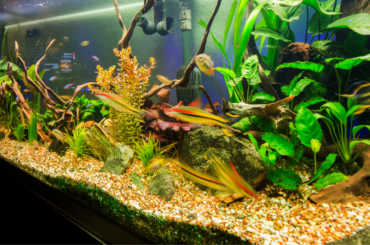If you’re thinking about getting a fish tank but are not quite sure how everything goes, this will be the place for you. Beginners’ Guide to Fishkeeping is a complete guide that you can use to learn A to Z about the aquarium hobby and how to set up your first aquarium.
Here, we will cover how to plan your first aquarium, set up and decorate your fish tank, accumulate new fish into the aquarium, and much more.
Table of contents
- How to Select Fish for Your First Aquarium?
- What are the Necessary Equipment to set up a New Aquarium?
- Where is the best place to put my aquarium?
- How to add substrate to the aquarium?
- Fish Tank Decoration
- How to set up the aquarium Air stone?
- How to set up the aquarium Filter?
- How to set up the Aquarium Heater?
- What is the easiest way to fill a fish tank?
- Fish Tank Lighting Setup
- Aquarium Cycling
- Why do you need to acclimate fish before releasing them into Aquarium?
- Different Practices of Acclimating Fish
- What is the best way of acclimating Fish to a new Aquarium?
- Why should you avoid mixing fish bag water with the Aquarium?
- How do you quarantine a new fish?
- How long should I quarantine new fish?
- Should you medicate the quarantine tank?
- Conclusion
So, let`s start with planning your first fish tank. The most important step in setting up your new aquarium is selecting suitable fish.
How to Select Fish for Your First Aquarium?
Sometimes, it might seem strange to select the fish before setting up the tank. But many future decisions like tank size, aquarium setup, and filter types are predicated on what kind of fish you’re keeping. So it’s better to make this decision at the beginning and set the tank up.
Which Fish Are Best for Beginners?
There are so many types of fish with different personalities and different habitats. So selecting suitable fish for your aquarium is not an easy task. It can be pretty overwhelming. You can’t just run into the aquarium shop, grab a handful of fish and throw them in the tank. If you do, you might be turning your tank into a battlefield.
So, it’s a decision that can take some time to make. So plan on doing some research. Take your time and enjoy this process. Here is a list of things to be checked before selecting the fish for your aquarium.
- Water Parameters
- Growth Rate
- Temperament
- Tank Setup
- Breeding Habitats
1. Water Parameters
The first thing to look for is the water parameters that your fish require. This will tell you whether your tap water at home is acceptable for the fish. Sometimes you might need to slightly adjust the pH and hardness to suit the fish you want to keep.
2. Growth Rate
The next thing you need to look for is how big these fish can potentially grow. It will also help you in deciding what size of the aquarium to get when you’re first setting up your fish tank. Otherwise, you will need a tank upgrade when your fish grows big.
3. Temperament
The temperament of your selected fish is a critical factor when you are getting tank mates for your fish. You may not keep all your preferred aquarium fish in one tank. Each fish has its own personality. So check whether your fish is aggressive, mildly aggressive, or a nice fish for others. It will help you to keep the peace in your tank.
4. Tank Setup
Before planning the tank setup, you need to know whether your fish is an open-water swimmer or a bottom dweller.
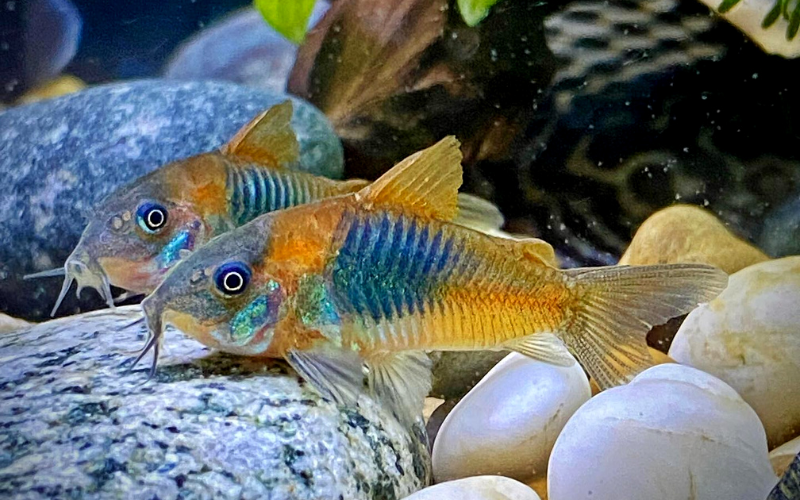
If you are a minimalist and don’t like a lot of decorations in the tank, it’s better to get open swimmers. But if you love really intricate, decorated tanks and rock formations, getting a fish that doesn’t require a lot of open space might make sense.
Bottom dwellers are pretty self-explanatory. They scavenge the bottom picking up leftover food or sometimes even snacking on other fish waste. So if you’re going to keep a lot of bottom-dwellers, you need to keep a lot of floor space open, for them to scavenge through.
5. Breeding Habitats
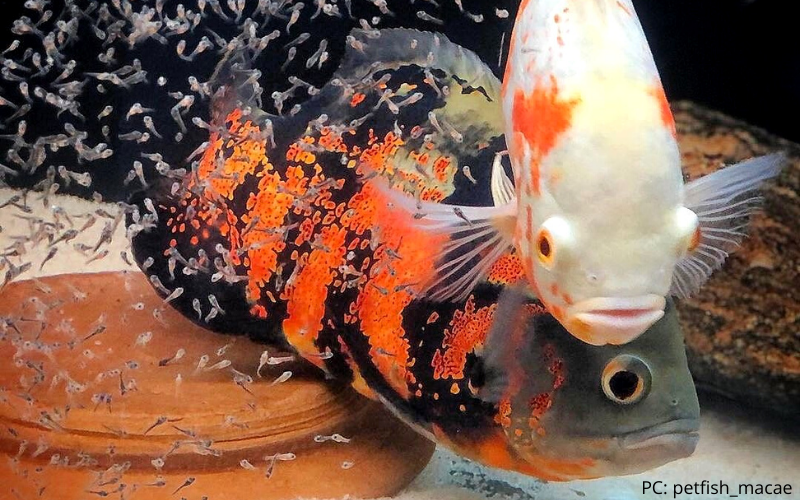
There are so many things that can happen in an aquarium if your fish starts breeding. Sometimes, their attitudes can change, and they can become violent towards other fish.
So if you don’t want your fish to breed in your tank, and if you don’t want babies in your tank, you should take the necessary steps to control breeding. So it’s better to know your preferred fish`s breeding habits before you buy them.
Some fish are difficult to breed in a domestic environment. But some fish varieties like platies, mollies, and sword-tails breed all the time.
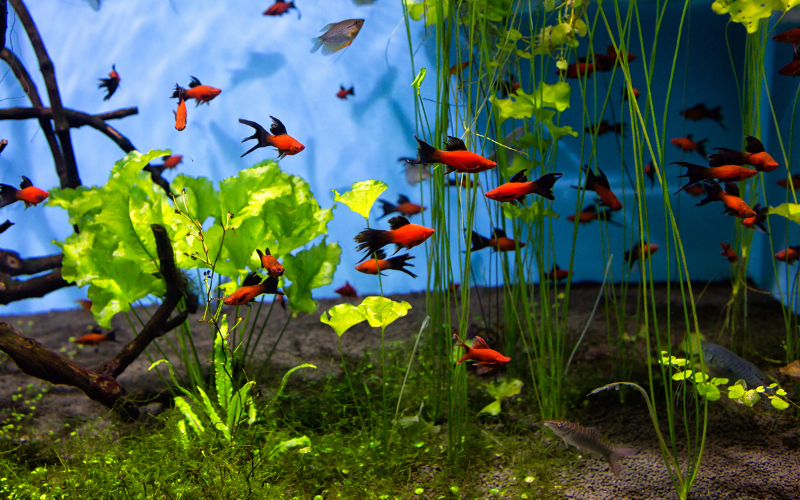
So if you are willing to keep those kinds of fish but don’t want babies, you should try to avoid their breeding. For example, you can get those fish from one gender and completely eliminate breeding chances.
So these are just a few of the important factors that you need to research before making the decision to go towards a certain type of fish. The information is out there and it’s easy to find. You could visit the fish in the pet store and ask Siri or type it into your phone and find out tons of information about that particular fish.
So don’t rush this, take your time and educate yourself about the fish that you’re interested in before you actually buy it. Then you will be saving yourself a ton of headaches down the road.
What are the Necessary Equipment to set up a New Aquarium?

After deciding what the fish types are, we’re going to talk about selecting the right equipment for your first aquarium. Let’s not get frustrated and keep it simple. These are the bare-bone essentials when you first get into the aquarium hobby.
- Fish Tank with Stand & Lid
- Aquarium Substrate
- Filter System
- Aquarium Lights
- Aquarium Heater & Thermometer
- Air Pump
- Fishing Net
- Necessary Chemicals
There are plenty of other gadgets and things that you can put in the aquarium. But as beginners, we’re just talking about the most important things that you need to start up your first aquarium.
Fish Tank with Stand & Lid
The fish tank, stand, and lid are the first things you need to set up your aquarium. Already, you have decided what type of fish you want, and that decision might lead you to know what size of tank you will need for that fish.
How many fish can I put in my tank?
One gallon of water per inch of fish is a popular rule of thumb among aquarists to determine the aquarium size. This rule states that your tank should be large enough to accommodate 1 gallon of water for every inch of fish you want to keep.
Although the rule of thumb can be used to get a rough idea about aquarium size, stocking your fish tank should not depend solely on that. There are some more factors to be considered. The right aquarium size totally depends on the fish that you are going to keep.
How do I choose the right size Aquarium?
Firstly, getting at least a 5-gallon tank for even a single fish is recommended. Low-capacity tanks under 5 gallons (such as fish bowls) are particularly vulnerable to pH changes and the accumulation of hazardous chemicals and waste materials.
It also doesn’t provide enough surface area necessary for healthy gas exchange. So even with a single fish, it can get disturbed and more susceptible to diseases.
Also, you should consider the fish’s body shape, growth rate, waste production, activity levels, temperament, and other environmental needs like temperature and water salinity.
So It’s important to do your own research to ensure that your aquarium is pleasant and accommodating for all of the fish you want to keep. The best approach to ensure that you establish the safest, most pleasant home for your fish is to thoroughly investigate different fish varieties and their environmental requirements.
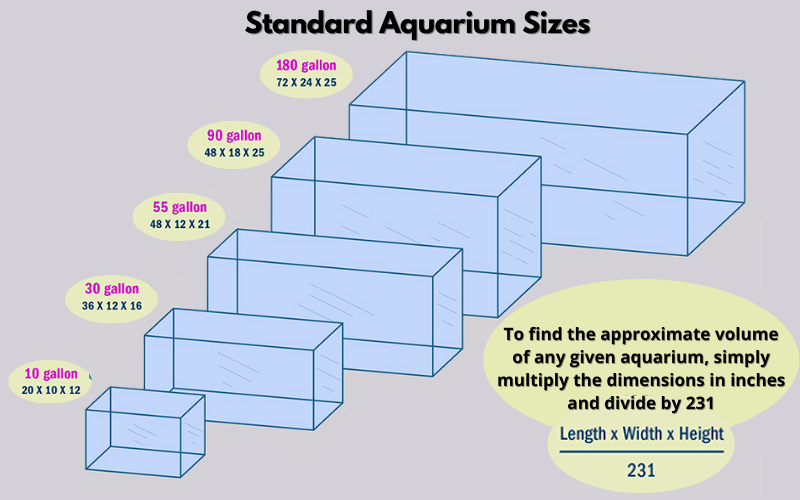
As a common, 55 gallons is the best aquarium size for a beginner. It’s great for a home as it doesn’t overpower a room. Also, it’s big enough to give you plenty of options.
Aquarium Substrate
Any loose material that makes up the tank bottom can be referred to as an aquarium substrate. Choosing the right substrate can be a bit complicated as there are different types, colors, and textures.
Do you need a substrate for the aquarium?
Aquarium substrate is not necessary for a fish tank. In fact, you can completely avoid it and set up a bare-bottom tank. An aquarium substrate has both pros and cons depending on the tank setup.
As an example, if you are setting up a planted tank, the substrate will be necessary for plants to root easily into the bottom. Also, if you plan to keep some kind of fish varieties like plecos and cories, they will prefer a tank set up with a suitable substrate.
What are the uses of Aquarium Substrates?
- Provide a natural habitat for aquatic life in the aquarium.
- Provide essential texture and nutrition for plant growth.
- Enhance the natural beauty of the aquarium.
- Providing enough surface area for beneficial bacteria colonies.
- Enhance the water condition by balancing water hardness and PH.
What are the different types of aquarium substrates?
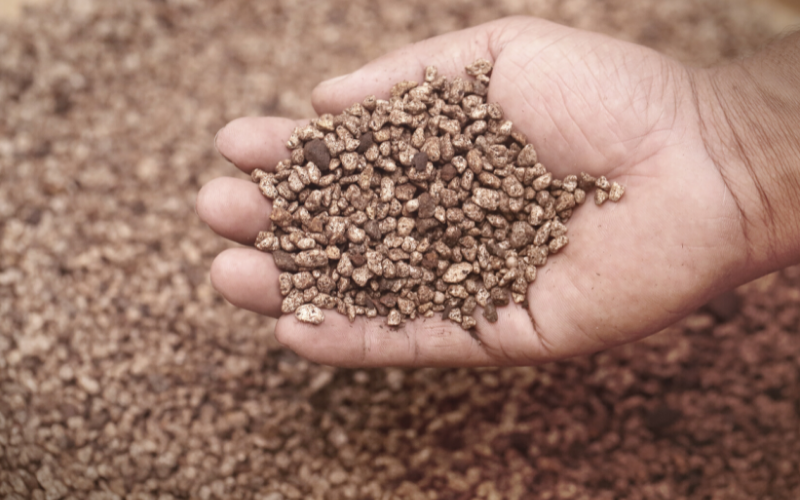
There are specific types of substrates to be used for different purposes, such as aqua soil for plants and fine coral sand for marine tanks. Here is a list of commonly used aquarium substrates.
- Pebbles
- Gravel
- Sand
- Aqua Soil
Read our “Ultimate Guide to aquarium substrates” for more information regarding different substrates and their pros and cons.
Filter System
The filter system is the life support system of an aquarium. This is one of the most important decisions that you’re going to make when you’re setting up your aquarium.
You have several different options and they all work fine; it just depends on how far you want to go with it. Read our “Ultimate Guide to Aquarium Filters” for a detailed review of all the different types of filters. Here is a quick recap of the most popular aquarium filters in the hobby.
Sponge Filters

Sponge filters are very simple filters that run off of an air pump. It’s easy to set up and easy to maintain. Normally, sponge filters are used in small tanks, but if you have a very limited budget, it’s ok to use a couple of sponge filters in a medium-scale tank, too.
Hang on the Back Filters
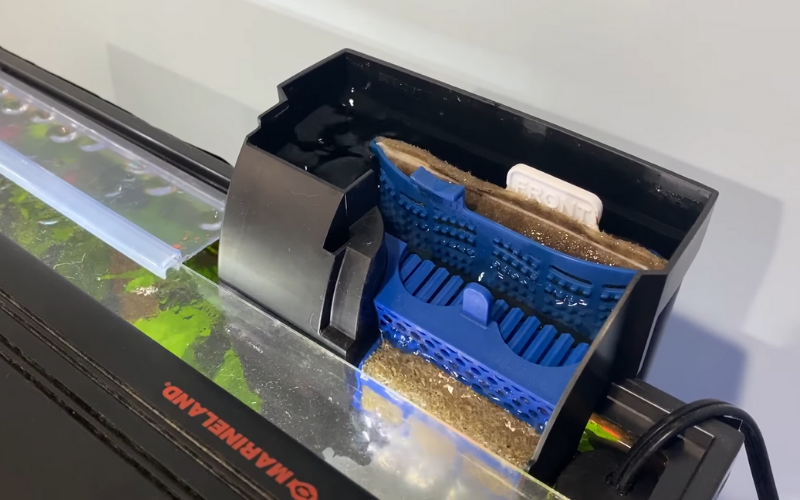
Hang on the back filters are pretty self-explanatory. They hang off of the back of your tank and have a tube that goes down into the tank to suck the water up into its filter. Then with gravity, it dumps over the side into your aquarium.
These are very efficient and probably the most common filters in the hobby. Also, you can pick them up just about anywhere. So for a beginner, Hang on the back filters are a good choice.
Canister Filters

Canister filters are the most efficient aquarium filters with a lot of functions. Also, they are absolutely silent and connect externally to the aquarium. Normally canisters are used in medium and large-scale aquariums.
But Canister filters are a little bit more expensive. So if you’re on a limited budget, It’s better to stick with Hang on the back filters that we discussed above.
Sump Filters
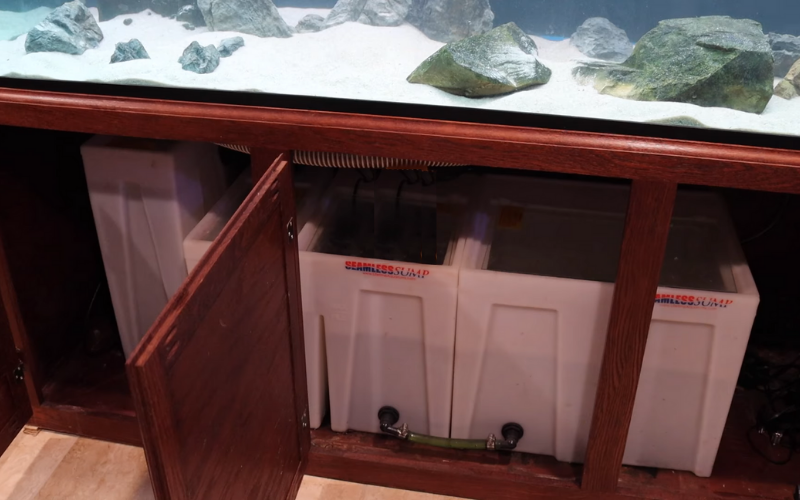
Sump filters are massive systems that will sit underneath your aquarium. They’re extremely efficient as canisters and used in medium and large-scale aquariums. But for a beginner, sumps can be a little bit complicated.
Aquarium Lights
Aquarium lighting may seem a little bit confusing with various types, brands, and some myths in the aquarium hobby.
Do Fish need lights in the Aquarium?
Proper lighting conditions are essential for aquarium fish to determine the day and night. Also, it is essential for the growth of your aquarium plants. But if there are enough natural lights in the daytime, it is not necessary to set up artificial lights in the aquarium.
However, if your aquarium is in a basement or a place where there is no sufficient light, it’s recommended to use an appropriate light. Also, aquarium lights can be used to enhance the natural beauty of your fish tank.
How to Select the Best Aquarium Light for Your Fish Tank?
When deciding on a suitable aquarium light, there are several important factors to be considered. The first one is the tank setup. Different aquarium startups, like freshwater, marine, and planted tanks, will need different lighting conditions.
Nest the aquarium size. The required brightness level depends on the length and depth of the tank. Also, the required lighting level may depend on the lifestyle of your fish. Not matching the right light illuminance and color may cause stress to your fish.
Finally, you should consider the budget. There are various types of lights from different brands. So after deciding the required brightness level, it’s better to balance the initial cost, electrical efficiency, lifetime, and product warranty of the light before purchasing.
Read our “Ultimate Guide to Aquarium Lighting” for more details about selecting a proper light and the pros and cons. Here is a list of common types of aquarium lights in the hobby.

- Fluorescent Lights
- LED Lights
- Metal Halide lights
Aquarium Heater and Thermometer
Aquarium heaters and Thermometers are essential to maintain the right temperature in your fish tank. It’s pretty simple and usually a glass cylinder that goes into the tank. It attaches to the side glass with suction cups.
Normally, your fish tank needs five watts per gallon of water. So when you get your heater, make sure to get the proper wattage for your aquarium size.
Aquarium Air Pump
Aquarium Air pumps are important to maintain the right Oxygen level in the water which is essential for life. Also, it helps to keep the water circulation through your tank by helping to increase the current.
As well as the moving bubbles from air stones can be used to decorate the aquarium with funny moving gadgets like a pirate’s chest or skull.
Aquarium Fishing Net
When you are cleaning the aquarium or in case of an emergency, you may need to transfer your fish from one tank to another. Then, some fish are very active and difficult to catch. In that case, aquarium fishing nets will be very useful. It allows you to catch the wanted fish without much effect.
Necessary Chemicals

When it comes to chemicals, there are so many different types that we can buy and use in our aquariums. Some of those chemicals are absolutely necessary, and some may not be so.
So, there are chemicals that help you take out the chlorine and chloramine from the water. Some chemicals help to condition the water and make it more tolerable for fish. There are bacterial cultures that you can add to speed up the biological filtration. There are medications and test kits that you can use to test your aquarium water. Fertilizers for your reef and your freshwater tanks. Buffer salts and a bunch of other additives that you can use to change the condition of the water and also help with the Filtration.
Likewise, there are various types of chemicals and it can be quite confusing for people that are getting into the hobby. Therefore try to keep it simple and just focus on a couple of things that are necessary at the startup.
What chemicals do you need to start a tropical fish tank?
Dechlorinator
So the first thing you need is some de-chlorinator to remove chlorine or chloramine from your water supply. Most people that have aquariums are getting water from the tap.
Very few fish keepers have access to reverse osmosis water, and equally, very few people have access to well water that isn’t contaminated with heavy metals fertilizers or chlorine.
So having some type of chlorine remover or some type of water conditioner that detoxifies chlorine and chloramine is going to be critical in keeping fish.
Aquarium Test Kits
The next absolutely important thing is some type of test kit. Test kits come in various forms. You can buy little strips of paper-type test kits that should be dipped in water to check the water parameters.
Also, some other test kits come with liquid chemicals. They should be added to a vial of water from your aquarium and check what’s going on in your tank.
Medications
Next up, if you want to speed up your aquarium cycling process there are some more chemicals that you can use. Also, It’s better to purchase some common medications like methylene blue which is used to prevent and treat harmful fungus.
As a newbie, you only need those main chemicals to start your first aquarium. Read our “Ultimate Guide to Aquarium Chemicals” to get a detailed view of all the other chemicals and their uses.
Now, there are plenty of other gadgets and things that you can put in the aquarium. But we just talked about the most important things that you need. Also, there are complete kits that include all the required equipment and chemicals to start an aquarium.
Up To now, You have decided what fish you will keep and according to that, you have planned what type of aquarium setup you will need. Next up, let’s discuss how to set up your aquarium, how to decorate it, and how to establish a quality environment before accumulating the fish.
Where is the best place to put my aquarium?

Fish tank placement is an important factor. Especially if you’re going to a large tank, the water in the tank alone weighs over a thousand pounds. So, placing the fish tank in your home is absolutely critical.
Normally outside perimeter of the house is good for your fish tank placement. Because those walls are usually going to be the strongest as they have the foundation below them. Also, if you are in a storied house, the ground floor will be the best.
Another thing to talk about is windows. If there is direct sunlight coming into your tank, it’s going to cause some kinds of algae problems in your tank. So think about the placement of the windows and how much direct sunlight will get.
Not only direct sunlight but even high-powered aquarium lights also can cause Algae problems. According to usual aquarium lighting practices, the ambient light in the room is enough for fish to thrive and survive.
As well as, if you live in a colder climate, in the wintertime, the cold air might come through the windows or doors, and then it may be a little bit harder to maintain a proper water temperature in your fish tank.
Another important thing is tank maintenance. So how close is your fish tank to the water source is also important. If your fish tank is closer to a sink or any other water source, it’s going to be a little bit easier.
Finally, you should place your fish tank where you can enjoy it. But consider staying away from overactive areas where you’ve got lots of action going. Because it might stress your fish.
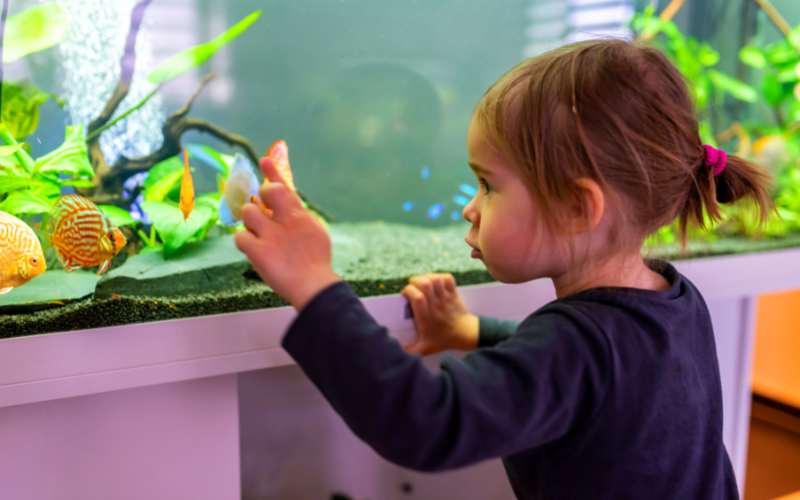
Once you have found that perfect spot in your home, it’s time to put all things together and set up your aquarium. Start with the substrate.
How to add substrate to the aquarium?
Aquarium substrate is an important part of your tank, So put some time into selecting the right substrate.
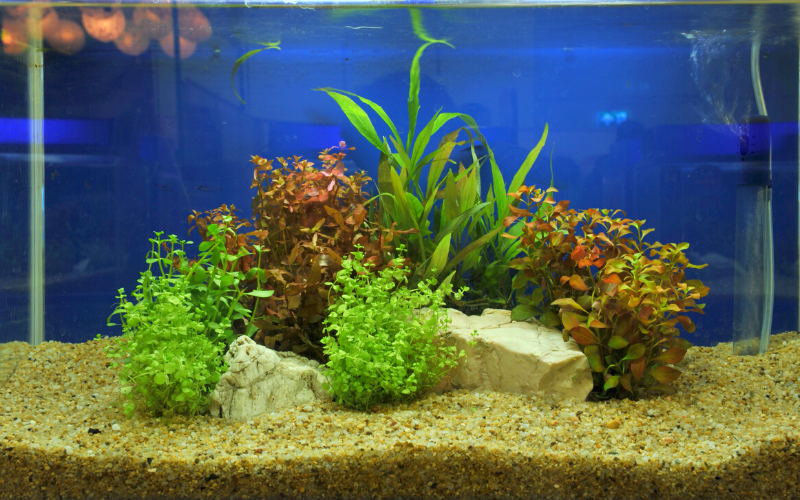
There is no particular rule on how much substrate you must have in your tank to keep it healthy, so just make sure you have good coverage across the bottom. But just remember, more substrate means somewhat difficult for maintenance. So don’t put it too deeply.
Fish Tank Decoration
Next up, start adding the aquarium decors that you selected. When selecting the aquarium decors, make sure to select items that are safe for your fish. You have to consider the material and shape of the aqua decors. Because if there are any sharp edges, it can damage your fish.
Always try to do the fish tank decoration before adding water. Because it’s just easier to see, and things will not try to float around.
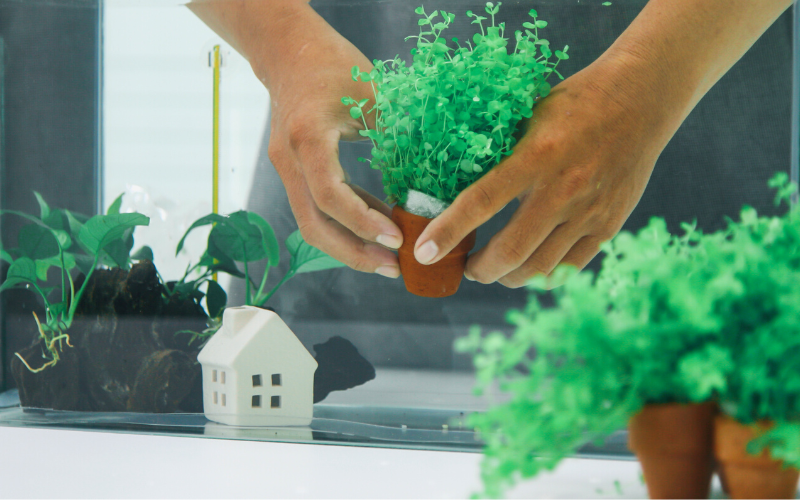
Decorating your aquarium is totally up to you. This is an opportunity for you to be artistic and make the tank your own little art project. So take your time and have fun with it. Finally, take a step back and look at it overall and see how things are going to look.
Then it’s time to start placing the equipment such as your aquarium filter, airstones, heaters, and lights. First, we have to place that equipment properly, and we can plug them in after filling the water. If you run these pieces of equipment dry with no water in them, a lot of them can burn up really quickly.
How to set up the aquarium Air stone?
Aquarium air stones are more than just decorations. They help provide current in the tank and keep water moving around. It helps to avoid any kind of dead zones in the fish tank.
You can use vacuum clips to properly manage the air tubes and place the air stone.

How to set up the aquarium Filter?
Then it’s time to install the filter. You should select a suitable filter for your aquarium according to the tank size, fish habitats, and other factors.
Actually, installation steps will somewhat vary according to your selected filter type. Therefore you can refer to the user manual of your filter to get an idea about the installation process.

Does aquarium filter placement matter?
The placement of the aquarium filter is very important. When placing your filter, you should consider getting the maximum water circulation throughout the tank. It should be able to push most of the fish waste into the filter.
Normally, it’s better to place your filter the way across the tank from your airstone. Because if your air stone is too close to your filter, it might get some of those bubbles sucked up into the filter, which can affect the efficiency of your filter.
The filter will also throw your bubbles all over the tank and just give a messy look.
How to set up the Aquarium Heater?
Placement of the aquarium heater is quite easy. First up, make sure to set up the correct temperature level that your fish will require. Then check whether there are any damages or leaks.
Where to place the Heater in your fish tank?
The location of your heater is pretty important. You should place it in an area with a lot of water movements so that the nice warm water gets spread throughout the tank and doesn’t just warm up one stagnant area.
Practically you can use the currents formed by the air stones or filter outlets. When placing it directly above the air stone, the air bubbles from the air stone will circulate and spread that nice warm water throughout the whole tank.
As well as, the bubbles will help you to hide the heater and may keep your eye directed away from it.
What is the easiest way to fill a fish tank?
After placing all the equipment, you can start filling your aquarium. You can simply use a garden hose to fill up your tank easily. By placing a bowl on the bottom of the tank where the water hits, you can avoid getting splashed around and redecorating your tank.
If you’re using buckets to fill your tank, you can do the same thing with a bowl. Just dump the bucket’s water straight into the bowl. It will keep things more settled at the bottom instead of just throwing everything around everywhere.
When the tank is filling up, that is a great time to add all of your water conditioners and other chemicals that you might be using, like quick starters or live bacteria. Just be sure to read the instructions on the products to ensure proper dosing of these chemicals.
Fish Tank Lighting Setup
After that, you can place your aquarium’s lids and lights. There are different types of lights with different types of fixtures. You should select an aquarium light with a suitable capacity.
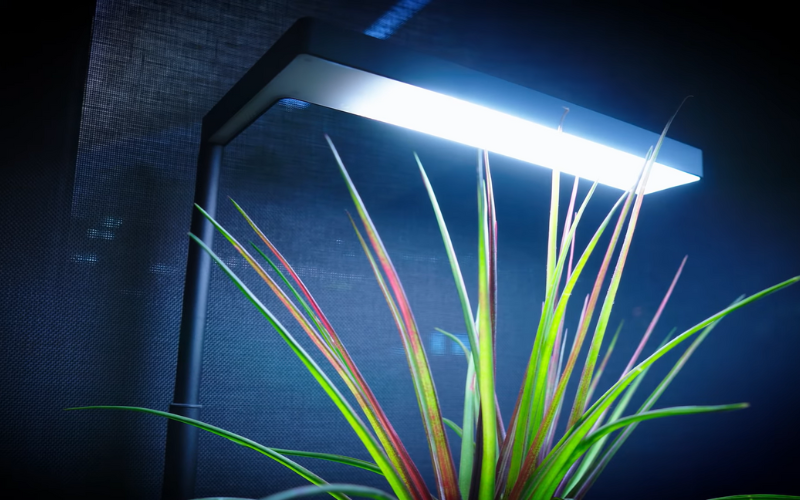
Now it’s time to plug everything in, and you are all set.
Just take a step back from the tank and make sure everything is functioning properly, including your filter, air stone, Aquarium lights and heaters. These things aren’t overly complicated, but you definitely want to take a step back to see how everything looks before you step back and just let nature take its course.
Aquarium Cycling
Finally, your aquarium is ready to go to the next stage; cycling your aquarium. It is the next most important thing that everyone should know in the hobby.
In the cycling process, we establish the Nitrogen Cycle in the aquarium. The nitrogen Cycle is the biological filter that removes toxic substances from your aquarium.
Normally cycling process will take up to 2-3 weeks. However, there are several methods and tactics to speed up the cycling process. It is absolutely critical for new aquariums and read our “Complete Guide Aquarium Nitrogen Cycle” to learn everything you need.
After setting up your fish tank, you may be wondering what is the best way to add your fish to your aquarium. There are several different ways of acclimating new fish to an aquarium.
But some of those fish acclimating practices can be deadly for your fish. So, let’s find out the best way to add your fish and why it’s beneficial to do the fish acclimation in that way. We will talk about the scientific background and underlying water chemistry.
Why do you need to acclimate fish before releasing them into Aquarium?
Adding fish into your aquarium seems pretty simple. But it can be somewhat stressful for the fish. Especially if you get your fish online, it will spend an entire day in a bag with a dark box.
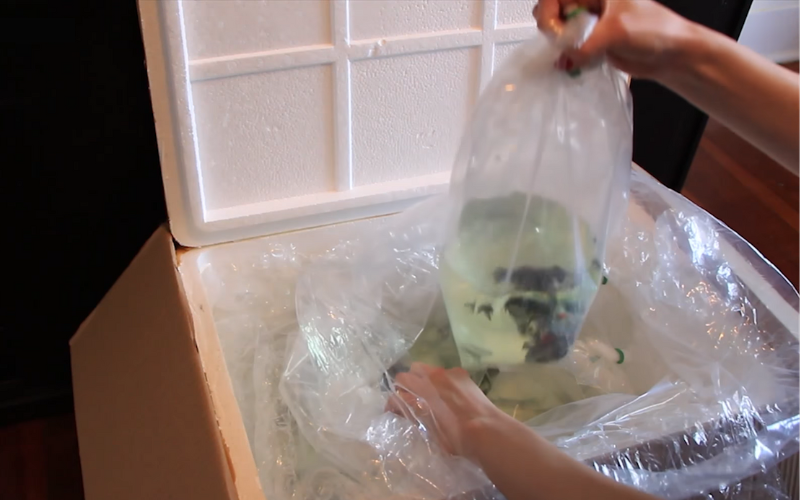
As well as, if it’s in a colder climate, the water temperature in the bag can go down. So if you add the fish directly into the tank, the sudden temperature difference can cause to stress out your fish.
When fish are stressed, their immune system becomes compromised, and fish are more prone to disease. So we want to make this process very simple and stress-free for the fish, and that’s why acclimation is needed.
Different Practices of Acclimating Fish
The first step of the fish acclimating process is to balance out the temperature. For that, we can use drip acclimation or the floating method. Also, switching off the aquarium lights during the acclimation process is recommended. It helps to keep your fish calm and stress-free.
Drip Acclimation method
Drip acclimation is one of the methods that many fishkeepers follow to add new fish to their aquariums.
First, we slowly mix the water from our tank into the fish bag and acclimate the temperature. After that, we can add the fish into the tank without mixing the fish bag water with our aquarium. For that, we can simply use an aquarium net or hand.
Plop and Drop (Floating) Method
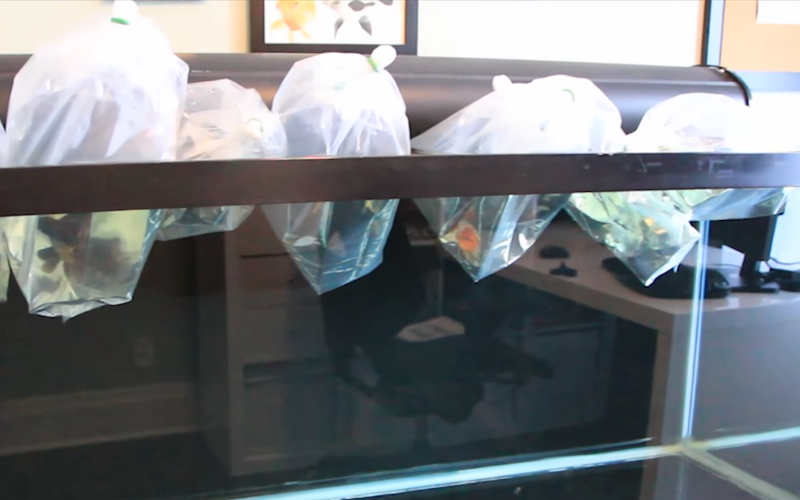
Plop and drop acclimation means first we let the fish bag float in the aquarium water. When floating, the water in the bag gets slowly balanced with the temperature in your tank. This may take up to 20 -30 minutes.
Once the temperature in the bag is the same as in your tank, you can add fish to the tank. Here also, we should not add the fish bag water into the aquarium.
What is the best way of acclimating Fish to a new Aquarium?
Both floating and drip acclimation methods can be used to add your fish into a new tank depending on the situation.
When considering the drip acclimation method, it takes somewhat less time to balance the water temperatures because you can easily and quickly match the bag temperature with the tank by mixing water.
So it is a good method, if you need to shift the fish immediately due to lack of oxygen or any other reasons. But there are some constraints. The scientific reasons behind those constraints are as below.
When fish are placed in a bag, they will release two different waste products. One is Ammonia, which can be very toxic to fish. The other thing is CO2, which can convert into Carbonic acid. With this Carbonic Acid, Ammonia becomes less toxic to fish.
But when you drip water into the bag, Carbonic Acid gets distilled, and Ammonia toxicity becomes prominent. So it can harm the fish, as they are already stressed due to long transport.
So many experienced fishkeepers recommend using the floating method to acclimate the temperatures though it takes more time than the drip method.
Why should you avoid mixing fish bag water with the Aquarium?
We should never mix the fish bag water into the aquarium. Because there could be harmful waste products, or water itself could be harboring some kind of fish disease. We should carefully take the fish out and slowly add them to the tank.

Now you might be thinking that, can`t the fish itself be a carrier for harmful diseases? Surely it can be possible. That’s why we need to quarantine fish before adding them into a stabilized aquarium.
How do you quarantine a new fish?
Quarantining new fish is very important before adding them to your main tank. Because your new fish might have a certain disease though they don`t show any systems at first.
There is a high risk of your new fish getting infected during their transition from wherever they were captured or bred to your tank. They are stressed during this transition, and they can catch many diseases.
You should keep a separate tank to quarantine your fish. If you don`t have additional tanks, you can simply make a DIY Quarantine tank for your fish.
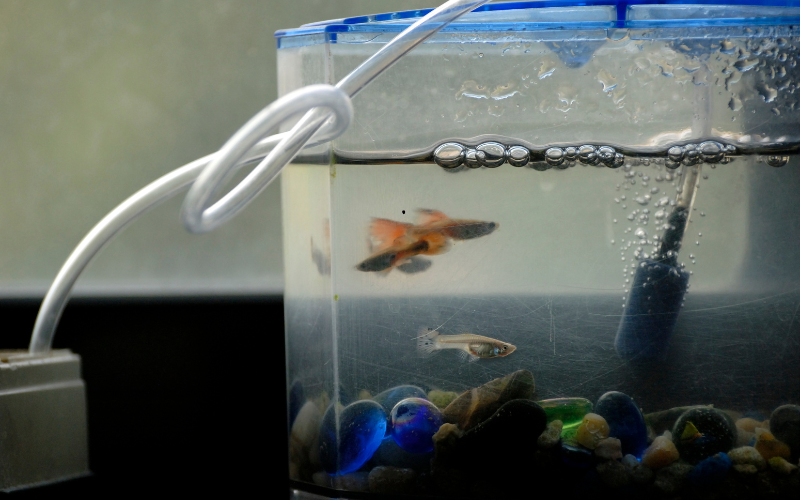
It’s better to cycle your quarantine tank too. If it is not cycled properly, you need to do tank maintenance and 50% water changes regularly to avoid accumulating toxic substances in the tank. You want to keep your tank as clean as possible during your quarantine process.
It`s recommended to avoid feeding too much. All the excess food you leave in your quarantine will only damage the parameters, spike your ammonia, and make the water unhealthy for your fish. You want them to be in the least stressful environment possible, and obviously, you want to keep an eye on them.
How long should I quarantine new fish?
Normally, it is recommended to quarantine your fish for two weeks. In this quarantine period, you should observe closely whether they show any symptoms of diseases. If you notice any sign of disease, you should take immediate action to treat that disease.
Should you medicate the quarantine tank?
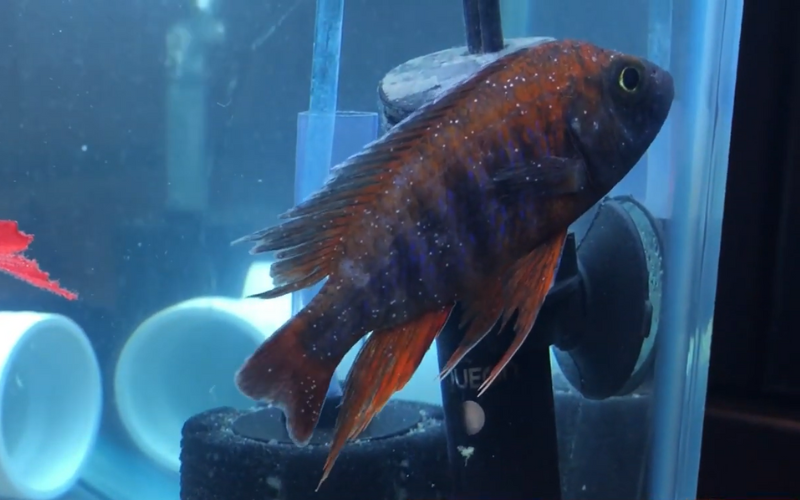
You can use general medications to treat your fish if they are not in severe disease. But you should take veterinary advice when treating critical diseases. Normally we can use aquarium salt without a veterinarian’s perception, and it can react against many minor diseases.
Another product that can be recommended is Stress Guard supplements. Stress Guard is a very good product used to reduce the stress in your fish, especially when adding new fish to a new tank or new quarantine in a new environment. This stuff comes in handy, and it also promotes healing.
As well as, don`t add any disease treatment unless you see symptoms. All medications add stress to your fish, so if it’s not needed, don`t add it. Your fish are already at a high-stress level. Their stress levels are the most important thing right now, and adding unnecessary medication will just elevate those stress levels.
Besides disease, another reason why you want to quarantine is just to check your fish’s physical condition. How battered did they get to you? Do they look extra stressed? Do they need a little healing time before going into the main tank?
So another thing you want to watch for during quarantine is how your fish are eating. If they are active and eating properly, it is a sign of good health.
Conclusion
Acclimating fish into your new aquarium shouldn’t be a big deal. It’s not a process that should take hours and hours, and you can do it without completely stressing your fish out.





